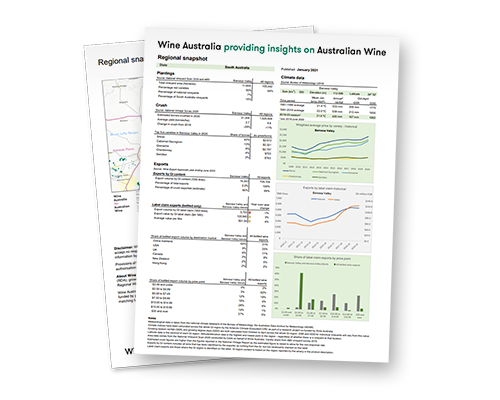Finding a home in Australia
The Pinot Noir variety has been in Australia since the early 1800s. It was also one of the varieties brought into Australia by John McArthur in 1817 and by James Busby in the 1830s.
It has taken time for this notoriously difficult grape to find success, but it is now thriving in the cooler viticultural regions across the country, such as Tasmania, Yarra Valley and the Adelaide Hills, as well as the warm inland regions. It is just as likely to end up in a classic traditional method sparkling wine as in a red table wine that James Halliday has described as ‘the nectar of the gods’.
It is the fourth largest red variety in Australia, but accounts for less than 3 per cent of the national crush.

Pinot Noir Variety Snapshot 2024-25
Variety snapshots are one-page profiles of individual Australian winegrape varieties and provide at-a-glance summary statistics on: viticulture data, winegrape production, winegrape price, key producing regions and export sales data compared against the same statistics for all wine grape varieties.
Download nowIn the vineyard
- True origin is of the variety is still unknown – it is thought to have been around for 2,000 years
- Our “heritage clone” MV6 is still widely cultivated today – newer Dijon clones arrived in the mid 1990s
- Pinot Noir is a notoriously fickle variety that is difficult to cultivate
- Early budding and relatively early ripening – susceptible to spring frosts as a result
- Produces the best results in temperate climates and when yields are kept low
- Delicate, thin skinned and prone to issue with botrytis bunch rot, downy and powdery mildew



In the winery

- Pinot Noir can be a challenging variety to vinify
- Fermentation temperature is a topic of discussion – warmer versus cooler
- Pre-fermentation cold soaks are used to enhance aromatics
- Whole bunch fermentation and stem inclusion techniques to add structure and complexity
- Pinot Noir is an important grape for the production on Traditional Method sparkling wines

- Pinot Noir has an affinity for new oak but care must be taken not to overwhelm the fruit profile
- Use of new French oak for maturation is common
- Move towards less new oak percentages and larger format barrels
Major regional expressions
Adelaide Hills
- Adelaide Hills is the leading region in South Australia for the production of Pinot Noir
- It is the third most planted grape in the Adelaide Hills after Sauvignon Blanc and Chardonnay
- Some of fruit from cooler sites goes into the production of Traditional Method sparkling wines
- The typical style of Adelaide Hills Pinot Noir tends to be more medium bodied with richer, ripe cherry and berry flavours
Mornington Peninsula
- Pinot Noir is the Mornington Peninsula’s most planted and most important variety
- The cooling effect of the Bass Strait is key to the success of Pinot Noir in this region
- The wines are typically medium-bodied with vibrant varietal characters of strawberry and cherry with a juicy backbone of acidity
Tasmania
- The inherent cool climate across Tasmania makes it idea for the production of high quality Pinot Noir
- The cooling effects of the Southern Ocean influence most vineyard areas on the island
- Some of the cooler grown fruit goes into the production of Traditional Method sparkling wines
- The Tasmanian style is light to medium bodied with delicate red apple, cherry and strawberry flavours
Yarra Valley
- Pinot Noir is the most planted and most important variety in the Yarra Valley
- Some of the cooler grown fruit goes into the production of sparkling wine
- A range of expressions of Pinot are produced in the Yarra Valley due to different elevations and aspects
- Typically light to medium bodied with flavours of cherry, strawberry and plum
In the glass
Style and character
Pairs with
Very versatile. Pork, chicken, pheasant, quail, beef, salmon, charcuterie, pate and terrines.
